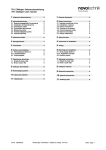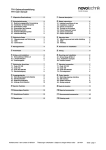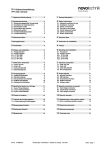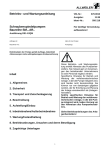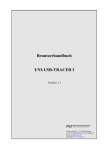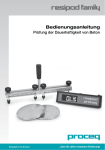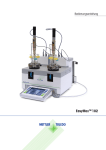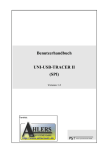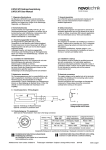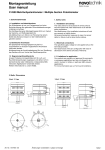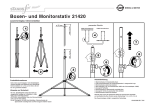Download TIM Montageanleitung TIM User Manual
Transcript
TIM Montageanleitung TIM User Manual 1 Allgemeine Beschreibung 2 1 General description 2 2 Sicherheitshinweise 2 2 2 2 2 2 2 Bestimmungsgemäße Verwendung Installation & Inbetriebnahme Anschlüsse prüfen Einschalten des Systems Messwerte prüfen Funktionsfähigkeit prüfen Funktionsstörung 2 2 2 2 2 2 2 2 2 Safety instructions 2.1 2.2 2.3 2.4 2.5 2.6 2.7 2.1 2.2 2.3 2.4 2.5 2.6 2.7 Intended conditions of use Installation & startup Check connections Turning on the system Check measured values Check functionality Failure malfunction 3 3.1 3.2 3.3 Elektrische Daten Massekonzept und Schirmung EMV Schweissen 3 3 3 3 3 3.1 3.2 3.3 Electrical data Machine ground and cable shielding EMC Welding 3 3 3 3 4 4.1 4.1 4.2 4.3 4.4 Montagehinweise Bohrung in der Kolbenstange Positionsgeber Steckflansch Ø 48 Schraubflansch M18 Allgemeine Information 4 4 4 4 4 4 4 4.1 4.2 4.3 4.4 4.5 Instructions for installation Bore diameter of piston rod Position marker Plug-in flange Ø 48 Screw flange M18 General information 4 4 4 4 4 4 5 Einbau & Installation 5.1 Steckflansch 5.2 Schraubflansch 5.3 Positionsgeber 5 5 7 9 5 Mounting & installation 5.1 Plug-in flange 5.2 Screw flange 5.3 Position marker 5 5 7 9 6 Elektrischer Anschluss 9 9 9 6 Electrical connection 6.1 Anschlussbelegung analoge Typen 6.2 Anschlussbelegung CANopen 6.1 Connection assignment analog versions 6.2 Connection assignment CANopen 9 9 9 7 Notwendiges Zubehör 9 7 Required accessories 9 8 Bestellcode 9 8 Ordering code 9 9 CANopen-Schnittstelle 9 9 CANopen Interface 9 Achtung! Bitte unbedingt beachten! Aufgrund von Produktanpassungen wurde die Anschlussbelegung (siehe Punkt 6) geändert. Caution! Please pay attention! Due to product changes the pin assignment (see point 6) was changed. Artikelnummer: 517991/07 Änderungen vorbehalten / Subject to change without notice 2014/11 Seite / page 1 TIM Montageanleitung TIM User Manual 1 Allgemeine Beschreibung 1 General description Die Baureihe TIM ist ein magnetostriktiver Wegaufnehmer für direkte, genaue und absolute Messung von Wegen bzw. Längen in der Steuerungs-, Regelungs- und Messtechnik. The TIM series is a magnetostricitve transducer for direct, accurate measurement of travel in display- or feedback applications. 2 Sicherheitshinweise 2 Safety instructions Unsere Produkte sind regelmäßig nicht für Luft- und Raumfahrtanwendungen zugelassen und dürfen nicht in kerntechnischen oder militärischen, insbesondere ABC-relevanten Applikationen verwendet werden. Weitere Informationen s. unsere AGBs. Our products are regularly not approved for aeronautic or aerospace applications and are not allowed to be used in nuclear or military, in particular ABC-relevant applications. For more information see our Terms and Conditions. 2.1 Bestimmungsgemäße Verwendung Der Wegaufnehmer wird zu seiner Verwendung in eine Maschine oder Anlage eingebaut. Er bildet zusammen mit einer Steuerung (z.B. SPS) ein Wegmesssystem und darf auch nur für diese Aufgabe eingesetzt werden. 2.1 Intended conditions of use The transducer is intended to be installed in a machine or system. Together with a controller (e.g. PLC) it comprises a position measuring system and may only be used for this purpose. Unbefugte Eingriffe, nicht bestimmungsgemäße Verwendung oder Nichtbeachtung der Montagehinweise führen zum Verlust von Gewährleistungs-, Garantie- und Haftungsansprüchen. Unauthorized modifications, improper usage or nonobservance of the instructions for installation will result in the loss of warranty and liability claims. 2.2 Installation & Inbetriebnahme Der Wegaufnehmer ist nur von Fachpersonal und unter Berücksichtigung aller geltenden Sicherheitsvorschriften in Betrieb zu nehmen. Alle Maßnahmen zum Schutz von Personen und Sachen bei einem Defekt des Wegaufnehmers müssen vor der Inbetriebnahme getroffen werden. Starke magnetische oder elektromagnetische Felder in unmittelbarer Nähe zum Wegaufnehmer können zu fehlerhaften Signalen führen! 2.2 Installation & startup The transducer must be installed by qualified personnel in consideration of all relevant safety regulations. 2.3 Anschlüsse prüfen Falsche Verbindungen und Überspannung können zur Beschädigung des Wegaufnehmers führen. Prüfen Sie deshalb vor dem Einschalten die Anschlüsse immer sorgfältig. Potentialdifferenzen zwischen Versorgung GND und Signal GND sind zu vermeiden. Durch Potentialdifferenzen zwischen Versorgung GND und Signal GND kann der Wegaufnehmer zerstört werden! 2.3 Check connections Improper connections and overvoltage can damage the transducer. Please always check the connections carefully before turning on the system. 2.4 Einschalten des Systems Das System kann beim Einschalten unkontrollierte Bewegungen ausführen, vor allem wenn der Wegaufnehmer Teil eines Regelsystems ist, dessen Parameter noch nicht eingestellt sind. Stellen Sie daher sicher, dass hiervon keine Gefahren für Personen und Sachen ausgehen können. 2.4 Switching-on the system The system may execute uncontrolled movements during first turning-on mainly when the transducer is a part of a control system whose parameters have not yet been set. Therefore make sure that hereof no dangers for personal and property can result. 2.5 Messwerte prüfen Nach dem Austausch eines Wegaufnehmers wird empfohlen, die Ausgangswerte in der Anfangs- und Endstellung des Positionsgebers im Handbetrieb zu überprüfen. (Änderungen oder fertigungsbedingte Streuungen vorbehalten) 2.5 Check measured values After replacing or repairing a transducer, it is advisable to verify the output values for the start and end position of the position marker in manual mode. (Transducers are subject to modification or manufacturing tolerances) 2.6 Funktionsfähigkeit prüfen Die Funktionsfähigkeit des Wegaufnehmers und aller damit verbundenen Komponenten ist regelmäßig zu überprüfen und zu protokollieren. 2.6 Check functionality The functionality of the transducer and all its associated components should be regularly checked and recorded. 2.7 Funktionsstörung Wenn der Wegaufnehmer nicht ordnungsgemäß arbeitet, ist er außer Betrieb zu nehmen und gegen unbefugte Benutzung zu sichern. 2.7 Failure malfunction If the transducer doesn‘t operate properly, it should be taken out of service and protected against unauthorized use. Artikelnummer: 517991/07 All necessary safety measures to protect personnel and property in case of a transducer defect or failure must be taken before startup. Strong magnetic or electromagnetic fields in close vicinity to the transducer may lead to faulty readings! Potential differences between supply voltage GND and signal GND must be avoided. With different potentials between supply voltage GND and signal GND the transducer can be destroyed! Änderungen vorbehalten / Subject to change without notice 2014/11 Seite / page 2 TIM Montageanleitung TIM User Manual 3 Elektrische Daten 3 Electrical data Versorgungsspannung: Mobilelektronik el. Code 6 _ _ und 8 _ _: 12 / 24 VDC ( 8 ...32 VDC) el. Code 9 _ _: 24 VDC (16…32 VDC) Stromaufnahme: < 100 mA typisch @12 VDC < 50 mA typisch @24 VDC Lastwiderstand RL : Spannungsausgang > 10 kΩ Stromausgang < 250 Ω @12 VDC Stromausgang < 500 Ω @24 VDC Supply voltage: Mobile electronics el. Code 6 _ _ and 8 _ _: 12 / 24 VDC ( 8...32 VDC) el. Code 9 _ _ : 24 VDC (16...32 VDC) Current consumption: < 100 mA typical @12 VDC < 50 mA typical @24 VDC Load RL: voltage output > 10 kΩ current output < 250 Ω @12 VDC current output < 500 Ω@24 VDC 3.1 Massekonzept und Schirmung 3.1 Machine ground and cable shielding Für den fehlerfreien Betrieb und zum Ausgleich von Potentialdifferenzen ist der Zylinder auf Maschinenmasse zu legen; dies ist meist durch den mechanischen Kontakt des Zylinders mit anderen Maschinenelementen gegeben. Falls der Zylinder isoliert mit der Maschine verbunden ist, muss eine separate Erdung z.B. durch ein Erdungsband an den Zylinder gewährleistet sein. Durch den metallischen Hydraulikzylinder ist der verbaute Sensor ausreichend geschirmt. Es ist daher werkseitig über den Stecker- oder den Kabelabgang keine gesonderte Schirmung geführt. Bei starken HF-Einstrahlungen ist es notwendig, geschirmte Leitungen zu verwenden. Dann muss jedoch anwenderseitig abhängig vom Massekonzept geprüft werden, ob der Schirm nur einseitig oder beidseitig auf Maschinenmasse gelegt wird. For correct operation and to compensate potential differences, the cylinder must be connected to machine ground. This is usually given by the mechanical contact of the cylinder with the other parts of the machine. If the cylinder is connected to the machine separately, a separate grounding must be ensured eg by an grounding strap directly to the cylinder. The built-in sensor is shielded sufficiently by the metallic hydraulic cylinder. Therefore, the factory does not provide a separate shielding via the connector or cable outlet. In case of strong HF interference, it is necessary to use shielded cables. It requires checking, depending on the user´s grounding concept, if only one side or both sides of the shield should be connected to machine ground. 3.2 EMV Die EMV Messungen wurden in einem ReferenzZylinder durchgeführt. Die gemessenen EMV-Werte können bei unterschiedlichen Zylinderausführungen jedoch deutlich abweichen! Bei kritischen Applikationen ist es daher notwendig, das Gesamtsystem einer eigenen EMV Erprobung zu unterziehen! Der rückseitige Flanschdeckel mit dem elektrischen Anschluss ist im Zylinder vollständig zu integrieren oder durch ein entsprechendes Gehäuse abzuschirmen! 3.2 EMC The EMC measurements were accomplished in a reference cylinder. The measured EMC values can however deviate clearly when using different cylinders! In critical applications it is therefore necessary to submit the existing complete system to its own EMC testing! The rear cover of the flange with the electrical connection must be completely integrated into cylinder or must be shielded by an appropriate housing! 3.3 Schweissen Bei Schweissarbeiten am Zylinder oder an angrenzenden Bauteilen ist folgendes zu beachten, damit es durch den Schweissstrom zu keinen Beschädigungen am Sensor oder an Dichtungen kommt: - der Sensor ist vor Schweissbeginn möglichst auszubauen - bei eingebautem Sensor sind alle Sensoranschlüsse während des Schweissens abzuklemmen - der Masseanschluss des Schweissgerätes darf niemals am Zylinder oder an der Kolbenstange befestigt werden 3.3 Welding When welding on the cylinder or adjacent components, the following must be observed to avoid any damage to the sensor or seals by welding current: - preferably, the sensor should be removed before welding - with a built-in sensor, all sensor connections must be disconnected during welding - the grounding connection of the welding unit must never be attached to the cylinder or the piston rod Artikelnummer: 517991/07 Änderungen vorbehalten / Subject to change without notice 2014/11 Seite / page 3 TIM Montageanleitung TIM User Manual 4 4 Montagehinweise 4.1 Bohrung der Kolbenstange Die Bohrung in der Kolbenstange ist abhängig vom Druck und der Verfahrgeschwindigkeit auszulegen. Empfohlener Bohrungsdurchmesser Dk ≥ 12,7 mm. Das Ende des TIM-Stabes ist vor Verschleiß zu schützen. Der Positionsgeber darf nicht auf dem Stab schleifen. Wird der Schraubflansch in einen Zylinder aus magnetisierbaren Material eingebaut, dann ist unbedingt darauf zu achten, dass der Abstand zwischen Positionsgeber in der Nullpunktstellung und dem Zylinder min. 15 mm axial beträgt! Instructions for installation 4.1 Bore diameter of piston rod The bore in the piston rod has to be laid out dependent on the pressure and the operating speed. The recommended bore diameter amounts to Dk ≥ 12,7 mm. The end of the TIM rod has to be protected against wear. The position marker may not touch the rod. When the screw flange will be mounted in a cylinder of magnetizable material, it‘s important that the axial distance between the position marker at the zero point and the cylinder is min. 15 mm. 4.2 Positionsgeber Für die direkte Hubmessung im Zylinder wird der Positionsgeber direkt auf dem Kolbenboden montiert: - Z-TH1-P18 und -P19: mit 2 Schrauben M3 oder M4 (je nach Positionsgeber), Anzugsmoment für M4 Schrauben max. 1 N. Alternativ kann der Positionsgeber auch durch einen Schraubring oder eine Einpressverbindung fixiert werden. - Z-TIM-P20: mit nichtmagnetischer Federscheibe und Sicherungsring. Die Aufnahme des Positionsgebers sollte über nichtmagnetisches Material (z.B. Edelstahl, Messing, Aluminium, Kunststoff) erfolgen. Gegebenenfalls ist eine nichtmagnetische Distanzscheibe (min. 5 mm stark) zwischen Positionsgeber und Kolbenboden zu montieren. 4.2 Position marker For direct stroke measuring in a cylinder the position marker has to be fixed directly on the cylinder‘s piston bottom: - Z-TH1-P18 and -P19: fixed with 2 screws M3 or M4 (depending on the position marker), Fastening torque for M4 screws max. 1 Nm. Alternatively the position marker can also be fixed by a threaded ring or by a press-fit-connection. - Z-TIM-P20: with non magnetic spring washer and circlip. 4.3 Steckflansch Ø 48 Der Sensor mit Flanschgehäuse Ø 48 mm wird in eine Passbohrung Ø 48 H8 eingebaut. Die Abdichtung des Flansches zum Zylinder erfolgt über den mitgelieferten O-Ring und den Stützring. Der Flansch des Sensors wird durch Gewindestifte M5 fixiert. 4.3 Plug-in flange Ø 48 The sensor with Ø 48 mm flange has to be mounted in a fitting bore Ø 48 H8. The sealing between the flange and the cylinder is realized with an O-ring and a support ring, which are included in delivery. The flange of the sensor will be fixed with M5 set screws. 4.4 Schraubflansch M18 Der Sensor wird mit Hilfe des Sechskantflansches (SW46) eingeschraubt. Hierbei darf das Anzugsmoment 50 Nm nicht überschreiten! Der mitgelieferte O-Ring dichtet den Druckbereich des Zylinders am Einschraubloch ab. Die Flanschauflagefläche muss vollständig an der entsprechenden Auflagefläche des Zylinders aufliegen. 4.5 Allgemeine Informationen Bei waagrechter Montage von Wegaufnehmern mit einem elektrischen Messbereich über 1000 mm empfiehlt es sich, den Stab am Ende abzustützen. Der Bereich für Kabel- und Litzenabgang muss ausreichend dimensioniert werden, der Mindestbiegeradius ist einzuhalten und scharfe Kanten sind zu vermeiden! Artikelnummer: 517991/07 For the mounting of the position marker non-magnetic material (e.g. stainless steel, brass, aluminum, plastic) should preferably be used. You have to mount a non-magnetizable spacer of min. 5 mm thickness between position marker and cylinder‘s piston bottom if necessary. 4.4 Screw flange M18 The sensor has to be screwed in via the hexagon flange (SW46). Here the fastening torque may not exceed 50 Nm! The provided O-ring seals the pressure area of the cylinder at the screw plug hole. The contact surface of the flange must rest completely against the mounting surface of the cylinder. 4.5 General information For horizontal mounting of the transducer with an electrical range longer than 1000 mm it is advisable to support or attach the rod at the end. For the area of the cable and lead wire please take care that enough space is available, the minimum bending radius must be observed and sharp edges must be avoided. Änderungen vorbehalten / Subject to change without notice 2014/11 Seite / page 4 TIM Montageanleitung TIM User Manual 5 Einbau / Installation Mechanische Ausführungen / Mechanical configuration Mechanische Ausführung / Mechanical configuration Flansch /Flange Code 305 Steckflansch / Plug-in flange Ø 48 mm Code 306 Schraubflansch / Screw flange M18x1,5 5.1 Steckflansch / Plug-in flange (Code 305) Kabelabgang / Cable connection * min. Biegeradius NT-Standardkabel: bei beweglicher Verlegung = 24 mm bei fester Verlegung = 5 mm min. bending radius NT standard cable: in case of movable assembly = 24 mm in case of fixed assembly = 5 mm Steckersystem M12x 1 / Plug system M12x 1 *** min. Biegeradius NT-Standardlitzen: bei beweglicher Verlegung = 10mm bei fester Verlegung = 3mm min. bending radius NT standard lead wires: in case of movable assembly = 10mm in case of fixed assembly = 3mm Artikelnummer: 517991/07 Änderungen vorbehalten / Subject to change without notice 2014/11 Seite / page 5 TIM Montageanleitung TIM User Manual Einbaubeispiel Kabelabgang / Installation example cable connection Einbaubeispiel Steckersystem M12x 1 / Installation example plug system M12x 1 ∅ Dk siehe / see 4.1 Einzelheit X, nichtmagnetisierbarer Werkstoff Detail X, non-magnetizable material Artikelnummer: 517991/07 Einzelheit X, magnetisierbarer Werkstoff Detail X, magnetizable material Änderungen vorbehalten / Subject to change without notice Einzelheit Y Detail Y 2014/11 Seite / page 6 TIM Montageanleitung TIM User Manual 5.2 Schraubflansch / Screw flange (Code 306) Kabelabgang / Cable connection * min. Biegeradius NT-Standardkabel: bei beweglicher Verlegung = 24 mm bei fester Verlegung = 5 mm min. bending radius NT standard cable: in case of movable assembly = 24 mm in case of fixed assembly = 5 mm Stecker M12x 1 / Plug M12x 1 Artikelnummer: 517991/07 Änderungen vorbehalten / Subject to change without notice 2014/11 Seite / page 7 TIM Montageanleitung TIM User Manual Einbaubeispiel / Installation example ∅ Dk siehe / see 4.1 Einzelheit X, nichtmagnetisierbarer Werkstoff Detail X, non-magnetizable material Einzelheit X, magnetisierbarer Werkstoff Detail X, magnetizable material ∅ 15,4x2,1 Einzelheit Y Detail Y Artikelnummer: 517991/07 Änderungen vorbehalten / Subject to change without notice 2014/11 Seite / page 8 TIM Montageanleitung TIM User Manual 5.3 Positionsgeber / Position marker 6 Elektrischer Anschluss / Electrical connection 6.1 Anschlussbelegung analoge Typen / Connection assignment analog versions Stecker / Plug 104 / 4_ _ Kabel / Cable 251 / 253 / 255 / 260 Signal el. Code 821* Signal el. Code 841* / 851* Signal el. Code 911* PIN 1 BN braun / brown + 12 / 24 VDC + 12 / 24 VDC + 24 VDC PIN 2 GN grün / green 4…20 mA 0,5…4,5 VDC 0,25…4,75 VDC 0…10 VDC PIN 3 WH weiss / white GND GND GND PIN 4 nicht anschliessen / nicht anschliessen / nicht anschliessen / nicht anschliessen / do not connect do not connect do not connect do not connect * Steigende Kennlinie ab Flansch / Rising characteristic from flange Polbild 4-polig M12x1 Flanschstecker bzw. Steckersystem A-codiert Pin Arrangement 4-pin M12x1 plug or plug system A-coded Konfektionierte Kabel können abweichende Farbbelegung aufweisen ! Customized cable may show different color coding ! 6.2 Anschlussbelegung CANopen-Schnittstelle/ Connection assignment CANopen interface Stecker / Plug 106 / 4 _ _ Signal el. Code 61_* PIN 1 Nicht angeschlossen / not connected PIN 2 + 12 / 24 VDC PIN 3 GND PIN 4 CAN high PIN 5 CAN low Polbild 5-polig M12x1 Flanschstecker bzw. Steckersystem A-codiert Pin Arrangement 5-pin M12x1 plug or plug system A-coded 7 Notwendiges Zubehör 7 Required accessories • • • • • • • Positionsgeber Z-TH1-P18 (Art.Nr. 005697) Positionsgeber Z-TH1-P19 (Art.Nr. 005698) Positionsgeber Z-TIM-P20 (Art.Nr. 005699) Position marker Z-TH1-P18 (P/N 005697) Position marker Z-TH1-P19 (P/N 005698) Position marker Z-TIM-P20 (P/N 005699) 8 Bestellcode / Ordering code TIM-_ _ _ _-_ _ _-_ _ _- _ _ _ Elektrischer Anschluss/ Electrical connection Elektrischer Messbereich / Electrical measuring range Mechanische Ausführung / Mechanical configuration 9 CAN Schnittstelle Die Beschreibung der CANopen Schnittstelle sowie das elektronische Datenblatt (EDS) sind zum Download auf der Novotechnik Homepage unter Downloads/Gebrauchsanleitungen verfügbar. Artikelnummer: 517991/07 Elektrische Schnittstelle / Electrical interface 9 CAN Interface The description of CANopen interface and the electronic data sheet (EDS) can be downloaded from Novotechnik web site, see Downloads/Operating manuals. Änderungen vorbehalten / Subject to change without notice 2014/11 Seite / page 9









